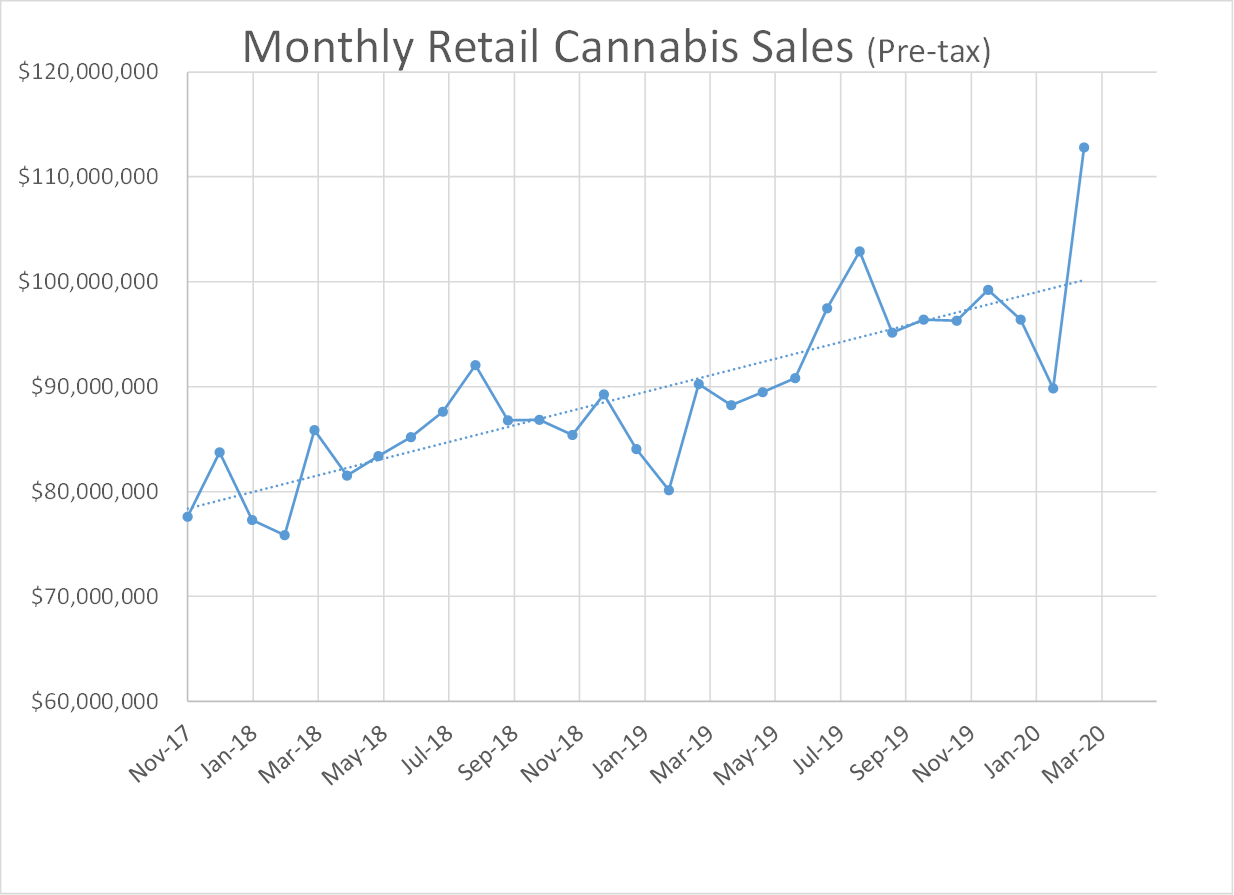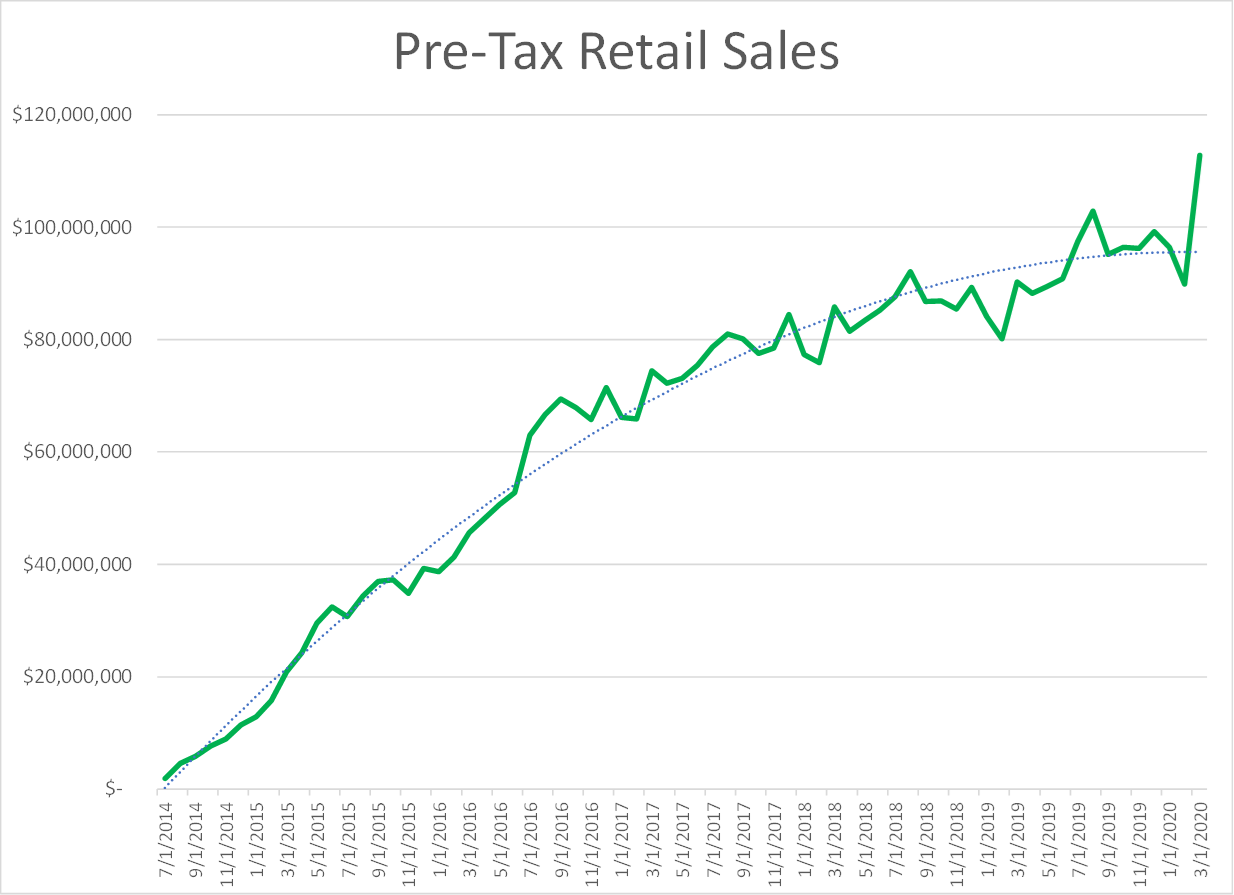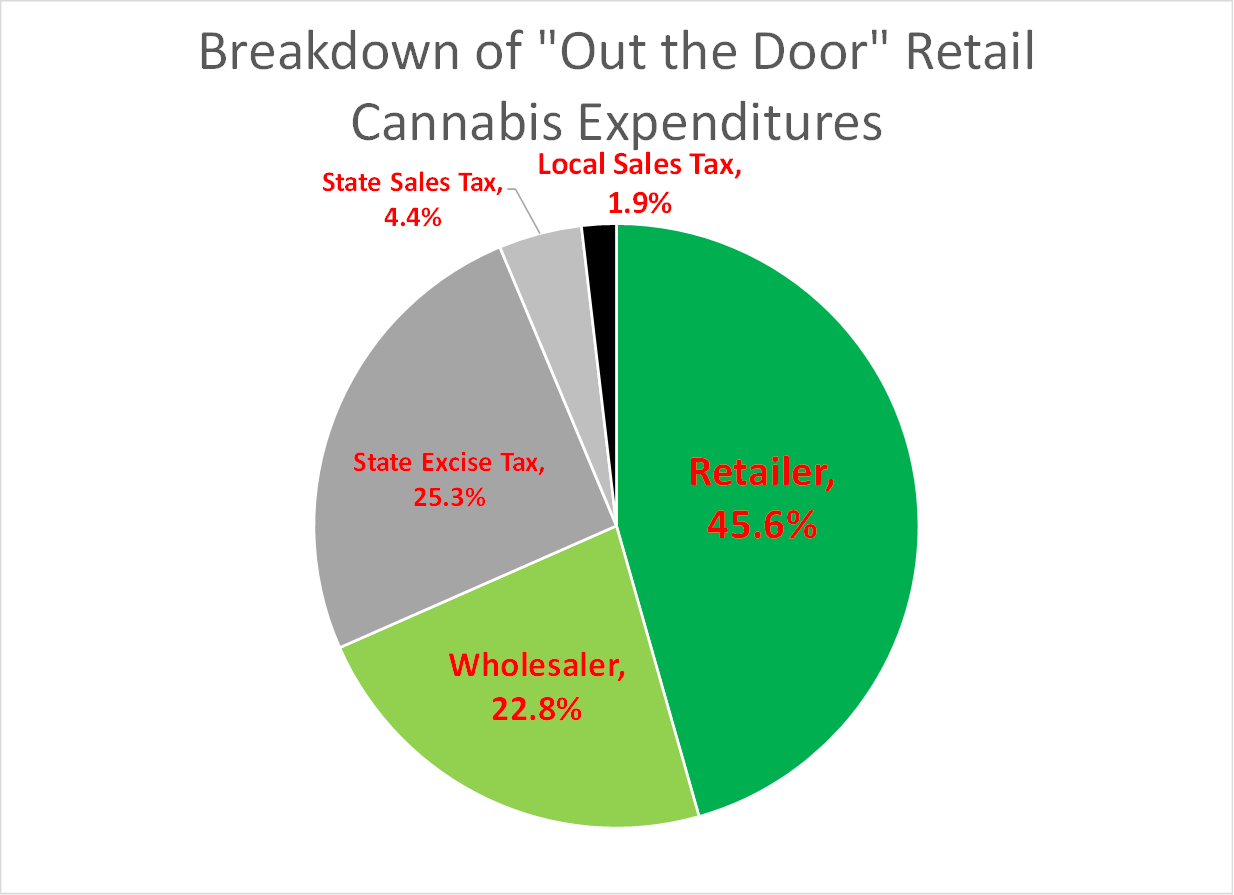In the context of some of the worrisome and disturbing events currenty unfolding, it’s a pleasure to be able to point out the one positive piece of “objective” data that I have seen so far this year relating to Washington State’s regulated cannabis market. TLDR: 2020 is not all bad, after all.
I say “objective” data because, although these data are provided by the WSLCB, they are based on reporting by retailers to the Department of Revenue for purposes of sales tax processing. Hence, the data are not dependent upon — or, more importantly, processed by — the MJ-Freeway/Akerna LEAF seed-to-sale traceability system that has severely compromised visibility into what has been happening in the regulated cannabis industry in Washington over the past 29 months.
Per the LCB’s most recent monthly licensee-level sales file, pre-tax retail cannabis sales in Washington state topped $100,000,000 in March. That matches a milestone seen only once before during the “Hempfest Bump” of August 2019, when just over $102.9 million of product was sold (pre-tax).
In March, pre-tax cannabis sales to consumers hit $112,811,413 — beating the Hempfest record by almost ten million dollars. The primary driver I can think of for this unexpected spike in sales is folks stocking up in the face of the pandemic and the anticipated possibility that stores might close down by order of the Governor. It might also reflect folks stocking up for the month that was at the time about to present a full month during which it would be 420 each and every day. We may never know for sure.
The March bump in sales is shown in the following chart covering monthly retail pre-tax sales during the 29 months currently comprising the “MJ-Freeway Years”.
It’s a good exercise to look at the same data series, but in the context of the larger set of monthly retail pre-tax sales totals going back to the inception of the market in mid 2014. I’ve knitted these data together from different sources and they reflect “truth” to the best of my knowledge.
Notice how the spike in March 2020 stands out more in the context of the overall trend. It truly is an outlier worthy of note.
During the 12-months ending in March, $1,155,038,213 worth of product was sold to consumers (pre-tax). During that same period, the actual out-of-pocket spend by consumers on cannabis and cannabis-containing products was about $1,688,781,000. This included about $507,882,000 in state taxes (excise, sales and B&O) and $31,300,000 in local sales taxes applied to the revenue stream created by the retailers.
Some fun facts:
$1.7 BILLION of consumer expenditures represent an average daily consumer out-of-pocket spend of almost $4.3 million dollars, statewide.
$1.7 BILLION of consumer expenditures also represent an annual average expenditure of just over $300 per adult Washingtonian. Those consumer expenditures are allocated across stakeholders in the regulated cannabis industry approximately as follows:
At the risk of feeding into speculation regarding the existence of a higher power that cares about such things, the pulse in retail sales during the month of March was generated by 420 stores. Did the market “know” that 4/20 was next in the monthly line or did it just feel that having more than 25% of the 566 retail access points allocated to serve consumer needs in this market inactive during it’s busiest month ever would be an amusing mystery to place out there for someone to worry about?
I’d put forward that doing $165 million in out-of-pocket consumer sales in a month — even one with 31 days — is not that bad – particularly given that 146 of the retail licenses awarded years ago were not even open for business.
It’s also not bad in that this level of sales already exceeds the most recent estimates put forward by the Economic and Revenue Forecast Council of Washington. Given the pandemic-initiated economic retraction, the legislature will be looking for revenue wherever it can reasonably and legally find it. That would seem to make the following observations all the more relevant and timely.
The $508 MILLION of annual direct tax revenue that cannabis retailers provide to the state now comprises over 2% of total state revenue. The indirects from their employees’ activity and those associated with their interactions with suppliers and service providers are not accounted for here. Nor is the plethora of new direct and indirect fees and charges being applied to the 1,000 + wholesalers included. Were they to be, then this market would be getting to represent somewhere around 3% of revenue received by the state.
This is an industry that is worth paying attention to. It is an industry that is worth regulating with competence. It is an industry worth regulating well. It is also an industry that, if regulated well, has the potential (as do the taxes it generates) to grow significantly beyond current estimates. Significantly beyond current estimates.
The Liquor and Cannabis Board has failed abysmally in their responsibilities and is, if anything, perpetuating the notion that cannabis is bad and, basically, criminal outside of the extreme constraints they have chosen to place on it’s commerce. The Department of Health does not even know how many cannabis patients it serves and goes further by failing to recognize cannabis as medicine and the Department of Agriculture behaves as if growing quite literally tons of this plant for profit — and contributing billions of dollars to the state economy — is not an agricultural activity.
This state is in dire need of a change in oversight of it’s regulated cannabis market.
I intend to detail some of the main issues in a new HI-Blog series covering the regulation of state-legal cannabis in Washington State as I see it in mid 2020. That series is to be titled “Aspiring to Mediocrity: The Regulation of Cannabis in Washington State”. Look for the first installment this weekend. It will be a high-level overview of the main issues I expect to detail in subsequent articles.
May the Twin Cities and elsewhere be peaceful tonight.
Nice article, Jim. I think that the record setting sales in March 2020 were probably a combination of stockpiling for 420 all month, and stockpiling for the pandemic / potential lack of availability. The designation of workers supporting cannabis retail as essential critical infrastructure workers in the food and agriculture sector was an excellent decision.
Looking forward to reading your upcoming article on Cannabis regulation in Washington State.
Thank-you, Erik.
I agree that the classification of the industry as essential was an excellent — and appropriate — decision.
What follows is the one bit of direct feedback I have gotten from the retail sector.
Bob from OZ on 3831 Stone Way N in Seattle confirmed a busy March, followed by slower than expected months in April and May. The gains he saw in March were attributable to 5 days of extremely busy “panic” buying. Various festivals and events which would normally draw people to the area have been cancelled and their absence was flagged as a contributor to the fall-off in business. As a note: Bob, the owner/operator of OZ is good guy with a great store … he has regularly shared open and honest observations about operating under this new regulatory framework and has offered up lots of information that has been helpful to many. I, personally, appreciate him.
Note — a store owner I don’t know just responded to Bob’s post (on another site) that his non-Seattle-area store has seen consistently strong — very strong — sales in April and May. Again — interesting, but I can’t vouch for someone I don’t know.
If any other retailers out there would like to share any other observations about how March, April and May were compared to normal and/or expectation, please feel free to share.
Funny thing is, I was just thinking about your blog and if you were still keeping it going a couple days ago. Interesting research as always, looking forward to aspiring to mediocrity! I appreciate you and everyone with a moral compass that is involved with this plant and the world of business, there are so few folks who value anything over money that it is truly disappointing to say the least.
Thank-you, Bjorn. I hope you are doing well during these interesting times.
Aspiring to Mediocrity has been a work in various stages of creation since last fall.
It’s going to be fun to switch to production.
Maybe someday I’ll have time to process.
Then sell?
Analysis is just like cannabis in that way — but tends to contain fewer pesticides, heavy metals and cannabinoids.
Jim, thank you for your thoughts and extrapolations! Do you have any other agricultural crops to compare tax revenue in our state? Cannabis is grown year round, how does it average put with other crops produced in our state?
Good day, Allison — I hope you are enjoying the thunder and lightning that is turning the great PNW into a nightclub this morning.
The WSDA has a great infographic based on data from 2016 that is at this link
In the box listing the top 10 agricultural commodities, they have a footnote that reads: “USDA Statistics exclude cannabis”.
If it were included, cannabis would definitely be in the top 10 statewide. Apples currently lead the way (2016) at $2.4 billion, milk at just over $1 billion and followed by potatoes, cattle, wheat, cherries, hay, hops, grapes and pears — which round out the top 10 at $233 million.
It depends on how the USDA measures agricultural commodity size (they are not, for example, including revenue from the food processing industry), but I’d imagine that cannabis would fall somewhere in the hops/grapes range of the top 10 list if measured accurately today (and in a manner consistent with how these other crops’ value was determined).
Remember that agricultural commodities are not normally valued by what they bring at retail. Farmers rarely see that money (except at Farmers markets — of which there were 170 statewide in 2016 —- with 40 Farmers markets serving King County alone).
At the same time, the WSLCB has been able to force the number of Patient Cooperatives Gardens to a number somewhere south of 20 last I checked. I am so looking forward to getting that “Aspiring to Mediocrity” series out the door.